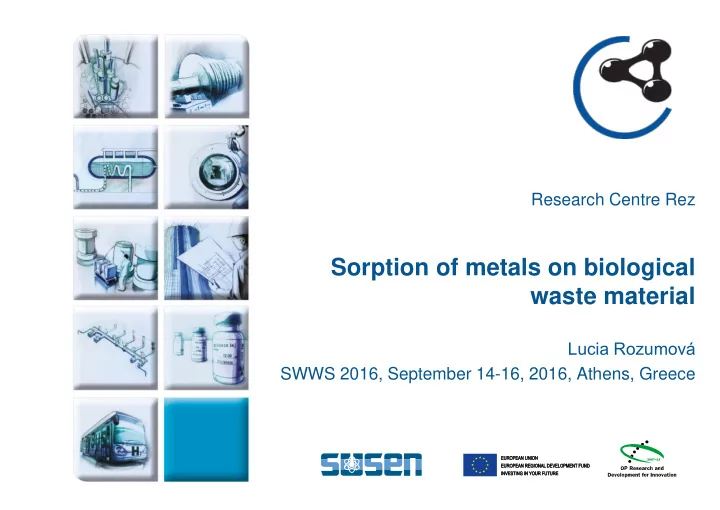

Research Centre Rez Sorption of metals on biological waste material Lucia Rozumová SWWS 2016, September 14-16, 2016, Athens, Greece
Goals Low-cost biological material – orange peel; Possible replacement for the current expensive adsorbent for a remove of heavy metals; Adsorption studies; Pb(II), Ni(II) ions from test metallic solutions; Investigate the efficiency of adsorption for the removal of heavy metal ions from different concentration of solutions; Assess experimental data by several types of adsorption isotherms. 1
Preparation of biosorbent Waste from locally available orange company; Grinding in a coffee mill – fraction smaller than ca 0.5 mm; Magnetic iron oxide nanoparticles – FERROFLUID; Orange peel in methanol mix (one hour) + rinse by methanol Ferrofluid 2
Reagents Water-soluble metal salts (Pb(NO 3 ) 2 , NiSO 4 · 7H 2 O compounds); Pb and Ni solutions were prepared at concentrations ranging from 1 to 1000 mg.L -1 ; Working solutions – by diluting the stock solutions. 3
Analytical techniques Surface – SEM with EDX (SEM LYRA3 TESCAN); Specific surface area – Quadrasorb EVO/S; Metal concentration – AAS-FA (UNICAM SOLAAR M6). 4
Sorption experiments magnetically modified orange peel + stock solution (with defined initial ion concentration) stirring and filtration 5
Isotherm study Langmuir adsorption isotherm model – homogenous adsorption surface; Freundlich adsorption isotherm model – heterogeneous system; Temkin adsorption isotherm model – the heat of adsorption of all the molecules in the layer decreases linearly with coverage due to adsorbent – adsorbate interactions; uniform distribution of binding energies, up to a maximum binding energy ; Dubinin-Radushkevich adsorption isotherm model – adsorption mechanism based on the potential theory assuming a heterogeneous surface. 6
RESULT AND DISCUSIONS 7
Material characterization Iron in the magnetically modified orange peel took forms: - magnetite (FeO.Fe 2 O 3 ) - wustite (FeO) - non-stechiometric iron oxide Specific surface area before modification – 0.45 m 2 .g -1 Specific surface area after modification – 1.60 m 2 .g -1 8
Morphological appearance 9
Morphological appearance 10
Effect of pH metal concentration – 10 mg.l -1 pH range 3 – 7 100 90 80 70 % Removal 60 50 40 30 20 10 0 2 4 6 8 pH Ni Pb 11
Effect of contact time metal concentration – 10 mg.l -1 time range 5 – 168 hours 100 90 % Removal Efficiency 80 70 60 50 40 30 20 10 0 0 20 40 60 80 100 120 140 160 180 Contact time (h) Ni Pb 12
Effect of initial concentration metal concentration range – 10 – 1000 mg.l -1 pH range – (Ni) 6-7 and (Pb) 4-5 200,00 160,00 Ni qe (mg.g-1) 120,00 Pb 80,00 40,00 0,00 0 200 400 600 800 1000 1200 ce (mg.l-1) 100,00 % Removal Efficiency 80,00 Ni 60,00 40,00 Pb 20,00 0,00 0 200 400 600 800 1000 1200 ce (mg.l-1) 13
Adsorption isotherms Isotherm Isotherm models Pb Ni constant The experimental q max (mg/g) 181.818 142.857 adsorption data were K L 0.010 0.001 described by the linear Langmuir R L 0.088-0.906 0.478-0.989 form of adsorption R 2 0.9530 0.1998 isotherms and the linear K F (l/g) 2.103 0.166 coefficient of n 1.938 0.767 determination (R2); Freundlich 1/n 0.516 1.303 R 2 0.9964 0.9134 b T 78 77 Temkin a T 0.139 0.012 R 2 0.8757 0.8744 a D 88.792 48.429 Dubinin-Radushkevich b D 7.301E-07 0.003 R 2 0.8509 0.8003 14
Adsorption isotherms The maximum monolayer coverage capacity: - 181.8 mg.g -1 (Pb) - 142.8 mg.g -1 (Ni); The linearized isotherm can be used to interpret the type of adsorption by using the values of R as follows: - R > 1.0 – not suitable; - R = 1.0 (0 < R < 1.0) – suitable; - R = 0 – irreversible; Sorption is favourable. 15
Adsorption isotherms K F and n are parameters characteristic of the sorbent-sorbate system; Correlate sorption data – 1/n is a heterogeneity parameter (the greater the expected heterogeneity); Value of parameter n indicates – favorable sorption process; Ni Pb 5 4 4 3 3 log a log a 2 2 1 1 0 0 1 2 3 4 5 6 -1 0 -1 0 1 2 3 4 5 6 -2 log ce log ce 16
Stability of an adsorbent Leaching of iron was observed during sorption experiments; The concentration of iron in solution after sorption and desorption was very low; The iron oxides are very strongly fixed onto the surface and that the material could be used as Pb and Ni sorbent. 17
Conclusions Magnetically modified orange peel was used to prepare a biological sorbent; Suitable material for sorption of metals Pb and Ni from water solution; Results indicate that the adsorbate formed a heterogeneous adsorbent surface; A better adsorption efficiency was for low concentration of Ni (60%) and Pb (90%); The results of this study indicated that magnetically modified orange peels can be used as low cost, eco-friendly adsorbent for Ni and Pb removal with high efficiency. 18
Acknowledgement Authors thank to the financial support of the Ministry of Education Youth and Sports NPU II Research for SUSEN and Project No. IPNOP 16D0010. This research was also supported by the Grant Agency of the Czech Republic (Project No. 13-13709S). 19
www.cvrez.cz Thank you for your attention lucia.rozumova@cvrez.cz 20
Recommend
More recommend